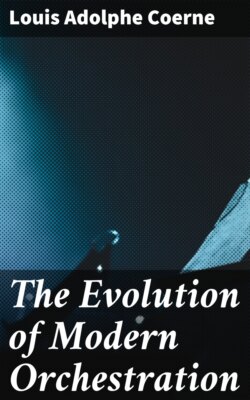Читать книгу The Evolution of Modern Orchestration - Louis Adolphe Coerne - Страница 33
I.
ОглавлениеBach (1685-1750), comparatively a recluse, was but little known to his contemporaries. His mode of life, however, was only partially responsible for this neglect, for the fact that a German imitation of Neapolitan methods was in predominance at that time, is of especial significance. Thus Haydn and Mozart, who might have reaped incalculable benefit from his experience, were unfamiliar with the greater portion of his works. This fact alone is sufficient to disconnect his name from the direct lineal chain of orchestral evolution. However, in view of the stupendous posterior influence his music was destined to wield, one cannot thus summarily pass over his contributions to orchestration.
Tersely stated, the ideal of this polyphonic giant revealed itself in subtle expression as concealed in his filigree of mercurial counterpoint, in the portrayal of inner feeling, and in profound religious fervor. A Teuton to the core, he stands as the symbolic exponent of organ and Protestant Church music. His arias are imbued with dramatic intensity and lyric pathos, and if at times portions of them seem archaic, one must remember that his art had assimilated the earlier church style and was but the corollary of it. His Passion Music not only still exists, but retains its full vitality. His church style is that of the organ, and the organ was for him the intermediary to orchestration.
Although Bach's instrumentation was by no means equal to the substance of his wonderful conceptions intended for orchestration, he did not neglect to study the prevalent Italian style of scoring, and was, to say the least, a progressive orchestrator, even if not an innovator. In his great organ works, the employment of chromatic and enharmonic modulation, the perfection of the fugue, the development of earlier strict forms eventually caused vocal music to yield precedence to instrumental. And Bach transplanted this polyphonic style into the orchestra with the result that the treatment of each individual instrument was distinctly melodic. Now this interwoven texture of austere polyphony, though resulting in a complete negation of analyzed tone-color, contained the essence of effective orchestral solo writing, as typified in his concerti grossi. Bach frequently employed the organ as the centre of his orchestra, though the instrument was never aggressive. Around it were clustered differentiated groups of the usual variety, whose mission it was to add specific unities of color rather than volume of sound.
But when Bach had occasion to introduce episodes of simplicity by way of contrast to his usual polyphony, his scoring for wood-wind was not so felicitous, and in loud passages, even when adequately represented, they were prone to be eclipsed by the strings. It is true that he was frequently hampered by a paucity of instrumentalists, but subsequent renditions of his orchestral works tend to prove that he failed to extract the best results from the wind. In uniting choral writing with the organ, Bach must evidently have been aware of the acoustic phenomenon that a literal redoubling of vocal and organ parts results in the complete absorption of the latter. For in his choral masterpieces, where the organ and orchestra are simultaneously used, we find, as a means of insuring contrast, passages wherein entire chords in the orchestra are employed as passing notes against held chords in the chorus and organ.
Bach's orchestration, therefore, stands for polyphony; melodic treatment in the voice-leading of each and every part both inner and outer; contrasted choirs of affiliated instruments for giving variety to the various sequent movements in relation to each other, rather than for episodic contrast or variety in the separate movements by themselves.
A striking contrast to Bach's secluded and uneventful career is to be found in that of his illustrious contemporary.
